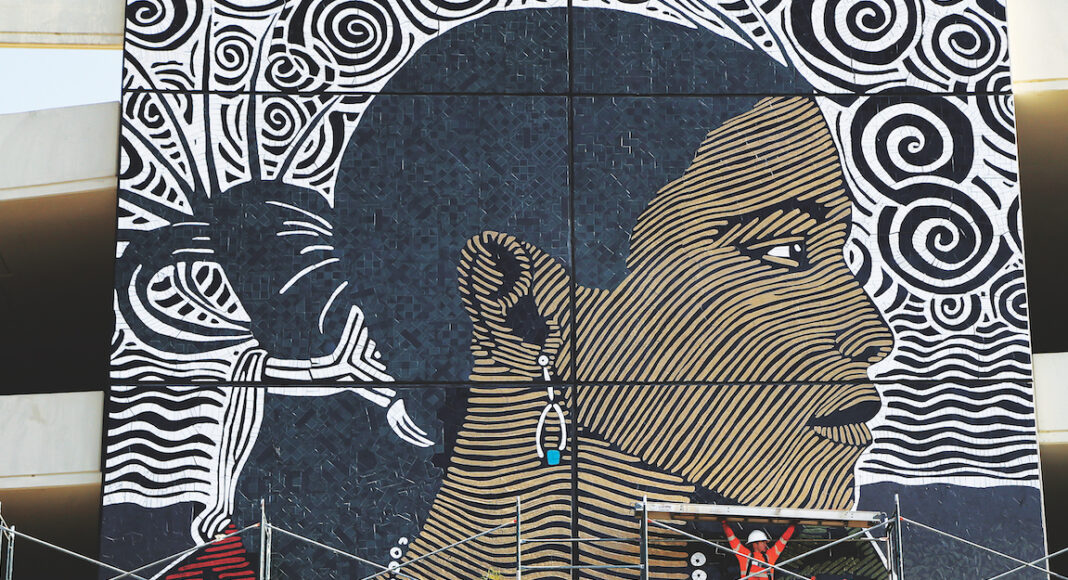Kathleen Crocetti had just returned from traveling in Europe when inspiration struck.
Crocetti had already been looking to bring more public art to South Santa Cruz County. But after 10 days of touring Barcelona with her husband Bill Lucas, soaking up the work of Antoni Gaudí, she was more invested than ever.
“I was thinking, I really would like to do a monumental piece,” Crocetti says. “I had lots of small projects scattered downtown. But not one big one.”
Crocetti, a recipient of the Rydell Visual Arts Fellowship Program, formed a plan for what would become Watsonville Brillante: a massive, five-year mosaic project at the Civic Plaza Building in downtown Watsonville.
The project, headed by Crocetti’s nonprofit Community Arts Empowerment (CAE), would span 12,500 square feet on the parking garage, with four large mosaics by one established artist and 185 smaller, horizontal panels of the garage by various local artists. The art would aim to reflect the diverse community of the Pajaro Valley—from its indigenous history through to present day immigrants.
Estimating the project would cost about $1.5 million, Crocetti began looking for donors. The first was Rinaldi Tile & Marble of Pajaro, who agreed to donate their time for installation. Crocetti worked with Susanne Brubeck, a lead project engineer at Rinaldi who runs the estimation department.
“She helped me stop losing money,” Crocetti says. “Prior, we were always making these [mosaics] and losing money. Now we’re breaking even. If it weren’t for [Rinaldi], this project wouldn’t have even gotten off the ground.”
Fireclay Tile of Aromas also came on board, with founder and Chief Ceramicist Paul Burns offering to be the sole tile provider—free of cost. Crocetti’s parents helped as well, becoming her first of six “angel donors” donating $20,000.
Finally, in February 2019, Watsonville Brillante was approved by the City Council. They also approved an agreement allowing Crocetti to lease the Muzzio Park Community Center, now the Muzzio Mosaic Art Center, for $1 a year. In return, she would develop a program to bring students and other volunteers to the center to create mosaics.
Selection Process
Artist Juan Fuentes was selected as the primary artist for Watsonville Brillante. A series of his pieces were released for voting by the community, with the top four being chosen for the vertical slots.
Fuentes, who owns Pajaro Editions studio in San Francisco, usually works in woodblock or linoleum, and admits he was unsure how his work would be transformed into an entirely new medium.
“I did not understand how this could be possible when I was first approached by Kathleen,” he says. “It has been a great opportunity for me to see my prints metamorphosize into something new.”
Fuentes was born in New Mexico before his family moved to Monterey County in the early 1950s. He was raised in Las Lomas, attending public elementary schools and Watsonville High School.
Brillante is Fuentes’ largest public work project. He said he was proud to have it happen in the town he grew up in.
“The many years that my family spent working in those agricultural fields and canneries have given rise to these mosaics,” he says. “I hope that the murals inspire everyone, especially the youth, that they see themselves reflected in the past and present and continue to struggle for a more just society.”
Fuentes called working with Kathleen and the other Muzzio volunteers “inspiring.”
“The few times that I have had the opportunity to visit and work on the mosaic along with other community volunteers and students has been wonderful and humbling,” he says.
Community involvement
Volunteers of all ages have been involved in the fabrication of Watsonville Brillante. High school youth looking to earn community service hours helped with “The Strawberry Picker,” which depicts a Mexican farmworker harvesting berries. The piece was installed in June 2020 after six months of work, plus a couple months of pandemic-related delays.
During the shutdown, volunteers would take shifts at the Muzzio to work on “The Apple Picker,” including eight students who participated in a summer camp at the center.
“In reality … about 16 people in total finished ‘The Apple Picker,’ in the same amount of time that 186 had finished ‘The Strawberry Picker,’” Crocetti says. “It was amazing.”
Such strong student involvement prompted Crocetti and CAE board president George Ow to kickoff a campaign for donors to give $25,000 each to pay youth interns.
“If they’re dedicated, we’ll hire them,” she says. “We now have two paid youth interns. We have funding to do three more. Five per year. We’re really excited to offer that opportunity.”
“Hermanita” was installed in October 2021. It depicts an indigenous woman, and is twice as big as the other pieces. Crocetti said that it took about a year to complete. In addition to center volunteers, Crocetti has created a mobile mosaic station that she takes with her to farmers markets, events and homeless centers.
“A bunch of ‘Hermanita’ was created out in the community,” Crocetti says.
Work has begun on the final mural, “The Flower Grower,” which depicts an Asian-American floral worker, as well as the horizontal sections.
Anyone interested in helping fabricate should visit communityartsempowerment.org/hours.













